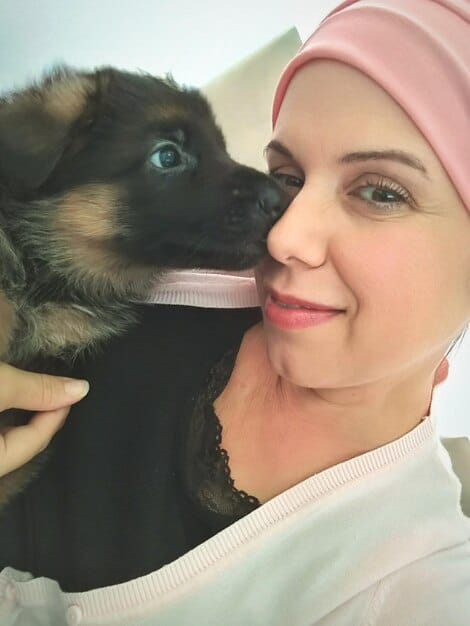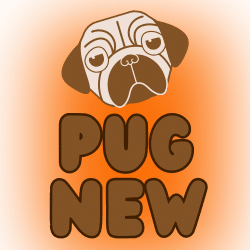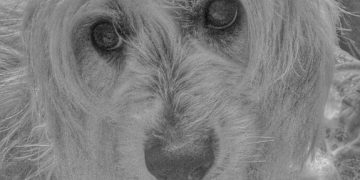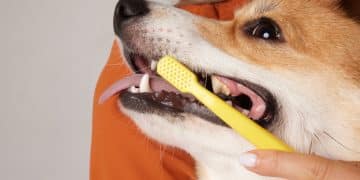Understanding Canine Cognitive Dysfunction: Helping Your Senior Dog Stay Sharp

Anúncios
Understanding Canine Cognitive Dysfunction (CCD) involves recognizing cognitive decline in senior dogs and implementing strategies like mental stimulation, a proper diet, and veterinary care to help manage symptoms and enhance their quality of life.
As our beloved canine companions enter their golden years, they may experience changes not only in their physical health but also in their cognitive abilities. Understanding Canine Cognitive Dysfunction is crucial for providing the best care for your aging dog and ensuring they maintain a high quality of life.
Anúncios
What is Canine Cognitive Dysfunction (CCD)?
Canine Cognitive Dysfunction, often referred to as CCD, is a neurodegenerative condition in older dogs, akin to Alzheimer’s disease in humans. It affects cognitive functions such as memory, learning, and awareness, leading to noticeable changes in behavior.
Recognizing the symptoms early and understanding the potential impact of CCD can help you provide appropriate care and support to your senior dog, ensuring they remain comfortable and engaged for as long as possible.
Anúncios
Common Symptoms of CCD
Identifying CCD can be challenging as symptoms often develop gradually. Here are some common signs to watch for:
- Disorientation and Confusion: Dogs may appear lost in familiar environments, struggle to find their way around the house, or get stuck behind furniture.
- Changes in Social Interaction: A previously affectionate dog might become withdrawn, irritable, or show reduced interest in interacting with family members or other pets.
- Sleep-Wake Cycle Disturbances: Dogs may sleep more during the day and become restless or agitated at night, sometimes leading to nighttime barking or wandering.
- Loss of House Training: Even dogs with a long history of being house-trained may start having accidents indoors.
These symptoms can significantly impact a dog’s quality of life and can be distressing for owners to witness. Early detection and management are crucial to alleviate these effects.

The Science Behind CCD
CCD is primarily caused by age-related changes in the brain, including:
- Accumulation of Beta-Amyloid Plaques: Similar to Alzheimer’s, these plaques disrupt normal brain function.
- Reduced Blood Flow: Decreased cerebral blood flow can impair cognitive function and lead to brain cell damage.
- Oxidative Stress: Increased levels of oxidative stress can damage brain cells and contribute to cognitive decline.
These pathological changes lead to a decline in neurotransmitter function, which is essential for communication between brain cells. This decline results in the cognitive and behavioral symptoms observed in dogs with CCD. Understanding these mechanisms helps researchers develop potential treatments and management strategies.
Recognizing CCD involves understanding its broad impact and subtle signs, enabling timely veterinary intervention and improved care strategies for your senior dog.
Diagnosing Canine Cognitive Dysfunction
Diagnosing Canine Cognitive Dysfunction (CCD) requires a thorough approach, as the symptoms can overlap with other age-related conditions. A definitive diagnosis is crucial for developing an effective management plan.
Effective diagnosis combines behavioral assessments, physical examinations, and diagnostic testing to confirm CCD and rule out other possible causes such as tumors or infections.
Behavioral Assessments
Behavioral assessments are a key component of diagnosing CCD. Owners play a vital role in this process by providing detailed observations of their dog’s behavior. Veterinarians often use questionnaires or standardized assessment tools to gather this information.
These assessments focus on identifying patterns and changes in behavior, such as disorientation, altered social interactions, sleep disturbances, and loss of house training. Documenting specific incidents and changes can help differentiate CCD from normal aging.
Physical and Neurological Exams
A comprehensive physical and neurological examination is performed to rule out other medical conditions that could be causing similar symptoms. This exam includes:
- Blood Tests: To assess organ function and detect systemic illnesses.
- Urinalysis: To check for urinary tract infections or other urinary issues that might explain house soiling.
- Neurological Exam: To evaluate reflexes, nerve function, and overall neurological health.
Ruling out other potential causes is essential before attributing the symptoms solely to CCD.

Ruling Out Other Conditions
Several other conditions can mimic the symptoms of CCD, including:
- Arthritis: Pain and stiffness can cause changes in behavior and reduced activity levels.
- Sensory Decline: Vision or hearing loss can lead to disorientation and anxiety.
- Brain Tumors: These can cause neurological symptoms similar to CCD.
Diagnostic tests such as MRI or CT scans may be necessary to rule out more serious conditions like brain tumors. Accurate diagnosis is crucial for proper management and care.
The diagnostic process involves a combination of behavioral evaluations, physical exams, and ruling out other conditions, offering a clear path toward understanding and managing your dog’s cognitive health.
Managing Canine Cognitive Dysfunction: Practical Strategies
Effectively managing Canine Cognitive Dysfunction (CCD) involves a multifaceted approach that integrates environmental modifications, mental stimulation, dietary adjustments, and, in some cases, medication. These strategies aim to alleviate symptoms and improve the overall quality of life for dogs with CCD.
Implementing these strategies can help to slow the progression of CCD and improve comfort and function for affected dogs and peace of mind for their caregivers.
Environmental Modifications
Adjusting the dog’s environment can significantly reduce stress and confusion associated with CCD:
- Ensure Easy Access to Resources: Keep food and water bowls, and resting areas easily accessible to prevent disorientation.
- Maintain a Consistent Routine: Stick to regular feeding and walking schedules to provide a sense of predictability.
- Reduce Clutter: Keep floors clear of obstacles to prevent accidents and reduce confusion.
These changes can provide a safer and more comfortable environment for dogs with CCD.
Mental Stimulation
Mental stimulation is essential for keeping the brain active and engaged:
- Interactive Toys: Puzzle toys and treat-dispensing toys can help stimulate cognitive function.
- Short Training Sessions: Simple commands and tricks can keep their minds sharp.
- Regular Walks: Exploring new environments and scents can provide mental enrichment.
Engaging in these activities can help slow cognitive decline and maintain mental alertness.
Dietary Considerations
Diet plays a crucial role in managing CCD. Certain nutrients and supplements can support brain health:
- Antioxidants: Vitamins E and C can help protect brain cells from oxidative damage.
- Omega-3 Fatty Acids: Found in fish oil, they can improve cognitive function and reduce inflammation.
- MCTs (Medium-Chain Triglycerides): Found in coconut oil, they can provide an alternative energy source for the brain.
Consulting with a veterinarian about a diet specifically formulated for brain health can be highly beneficial.
Medication
In some cases, medication may be necessary to manage the symptoms of CCD:
- Selegiline: This drug can help increase dopamine levels in the brain, improving cognitive function.
- Other Medications: Depending on the specific symptoms, anti-anxiety medications or sleep aids may be prescribed.
Pharmaceutical interventions should be determined and monitored by a veterinarian to ensure safety and effectiveness. It is not the veterinarian who provides the medication.
By integrating simple environmental adjustments with proactive mental activities, customized nutritional plans, and appropriate medical treatments, it is possible to greatly support and increase the quality of life for dogs suffering from cognitive impairment.
The Role of Diet and Supplements in Cognitive Health
Diet plays a pivotal role in managing Canine Cognitive Dysfunction (CCD). Specific nutrients and supplements can support brain health, improve cognitive function, and slow the progression of CCD.
A well-balanced diet rich in specific nutrients can provide the building blocks and energy needed for optimal brain function, helping manage the symptoms of CCD.
Key Nutrients for Brain Health
Several key nutrients have been identified as beneficial for brain health in dogs:
- Antioxidants: Vitamins E and C, selenium, and beta-carotene protect brain cells from oxidative damage caused by free radicals.
- Omega-3 Fatty Acids: DHA (docosahexaenoic acid) and EPA (eicosapentaenoic acid) are essential for brain cell structure and function.
- B Vitamins: B vitamins, including B6, B12, and folate, support nerve function and neurotransmitter production.
Incorporating these nutrients into your dog’s diet can help maintain and improve cognitive function.
Best Dietary Sources
Identifying the best dietary sources of these key nutrients is essential for formulating a brain-healthy diet:
- Fish Oil: Excellent source of omega-3 fatty acids, particularly DHA and EPA.
- Fruits and Vegetables: Berries, spinach, carrots, and pumpkin are rich in antioxidants and vitamins.
- Fortified Dog Food: Many commercial dog foods are fortified with essential nutrients for brain health.
Choosing high-quality ingredients and consulting with a veterinarian can help you create a tailored dietary plan.
Supplements
In addition to a balanced diet, certain supplements can provide extra support for dogs with CCD:
- MCT Oil: Medium-chain triglycerides (MCTs) provide an alternative energy source for the brain.
- SAMe (S-Adenosylmethionine): Supports liver function and has antioxidant properties for brain health.
- Phosphatidylserine: A phospholipid that helps maintain cell structure and supports cognitive function.
Always consult with a veterinarian before adding supplements to your dog’s diet to ensure they are safe and appropriate.
Optimal diet and supplementation, carefully selected for your dog’s specific needs, can greatly enhance their mental health and minimize the consequences of cognitive impairment.
The Importance of Mental and Physical Exercise
Mental and physical exercise are crucial for managing Canine Cognitive Dysfunction (CCD). Regular activity helps to keep the brain active and engaged, slowing cognitive decline and improving overall well-being.
Combining mental and physical activities provides a holistic approach to managing CCD, enhancing both cognitive function and physical health.
Mental Stimulation Activities
Engaging your dog’s mind with various activities can help maintain cognitive function:
- Puzzle Toys: These toys require dogs to solve problems to access treats, stimulating their minds.
- Training Sessions: Short, positive reinforcement training sessions can keep their minds sharp.
- New Environments: Exposing your dog to new sights, sounds, and smells during walks can provide mental enrichment.
Frequent mental stimulation can help delay the progression of CCD.
Physical Exercise
Regular physical activity is important for maintaining overall health and cognitive function:
- Daily Walks: Regular walks not only provide physical exercise but also mental stimulation through exploring new environments.
- Playtime: Games like fetch or tug-of-war can offer both physical and mental engagement.
- Swimming: A low-impact exercise that is gentle on the joints while providing a full-body workout.
Tailor the intensity and duration of exercise to your dog’s physical abilities and health condition.
Combining Mental and Physical Exercise
Integrating mental and physical activities can provide the most significant benefits:
- Agility Training: A fun way to combine physical exercise with mental challenges.
- Scent Work: Training your dog to find specific scents can provide both mental and physical stimulation.
- Interactive Walks: Incorporate commands, puzzle toys, and new routes into your walks.
This comprehensive approach ensures balanced engagement, enhancing both mind and body wellness.
By strategically weaving together activities that promote mental sharpness and physical agility, you can significantly affect the cognitive health of dogs with CCD, offering them a richer and more engaging life.
Creating a Supportive Environment for Dogs with CCD
Creating a supportive environment is essential for improving the quality of life for dogs with Canine Cognitive Dysfunction (CCD). A comfortable, safe, and predictable environment reduces stress and confusion, helping dogs better manage their symptoms.
Implementing environmental modifications, maintaining a consistent routine, and providing emotional support can greatly improve the well-being of dogs with CCD.
Environmental Modifications
Adjusting the home environment can make a significant difference in reducing stress and confusion:
- Ensure Easy Access to Resources: Keep food and water bowls, bedding, and potty areas easily accessible.
- Reduce Clutter: Clear pathways and remove obstacles to prevent accidents and confusion.
- Provide Soft Bedding: Comfortable and supportive bedding can help senior dogs rest more comfortably.
Maintaining a Consistent Routine
A predictable routine can provide a sense of security and reduce anxiety:
- Regular Feeding Times: Consistent meal times can help regulate their internal clock.
- Scheduled Walks: Regular walks at the same time each day can provide predictability and reduce disorientation.
- Consistent Bedtime: Establishing a consistent bedtime routine can improve sleep patterns.
Providing Emotional Support
Emotional support is just as important as environmental modifications and routine:
- Spend Quality Time: Regular interaction and affection can provide comfort and reduce anxiety.
- Use Calming Language: Speak in a gentle and reassuring tone.
- Avoid Stressful Situations: Minimize exposure to loud noises, unfamiliar people, or stressful events.
Implementing these strategies can help senior dogs feel more secure and loved.
Conclusion
Understanding Canine Cognitive Dysfunction is essential for providing compassionate care for our aging canine companions. By recognizing the symptoms early, implementing appropriate management strategies, and creating a supportive environment, we can help senior dogs maintain a good quality of life despite cognitive decline.
| Key Point | Brief Description |
|---|---|
| 🧠 Recognize CCD | Identify symptoms like disorientation, altered interactions, and sleep disturbances early. |
| 🩺 Consult Vet | Get a professional diagnosis to rule out other conditions and create a management plan. |
| 🏠 Modify Environment | Ensure easy access to resources, maintain a routine, and reduce clutter. |
| 🐾 Mental & Physical Activities | Incorporate puzzle toys, training sessions, and regular walks to stimulate the brain and body. |
Frequently Asked Questions
▼
CCD is primarily caused by age-related changes in the brain, including the accumulation of beta-amyloid plaques, reduced blood flow, and oxidative stress, similar to Alzheimer’s disease in humans. These changes disrupt normal brain function.
▼
Diagnosis involves behavioral assessments, physical and neurological exams, and ruling out other conditions. Veterinarians use questionnaires and diagnostic tests to differentiate CCD from other age-related issues with similar symptoms.
▼
Unfortunately, there is no cure for CCD. However, management strategies can help slow the progression and alleviate symptoms. These strategies include environmental adjustments, mental stimulation, dietary changes, and medication.
▼
A diet rich in antioxidants, omega-3 fatty acids, and medium-chain triglycerides (MCTs) can support brain health. Consult with a veterinarian about a diet specifically formulated to keep your dog with brain-boosting ingredients.
▼
Use puzzle toys, engage in short training sessions, and take regular walks in new environments to provide mental enrichment. These activities help keep their minds active and engaged, slowing cognitive decline.
conclusion
By understanding and addressing the symptoms of CCD, providing appropriate care, and creating a supportive environment, we can significantly improve the quality of life for our senior dogs, ensuring they enjoy their golden years to the fullest.






